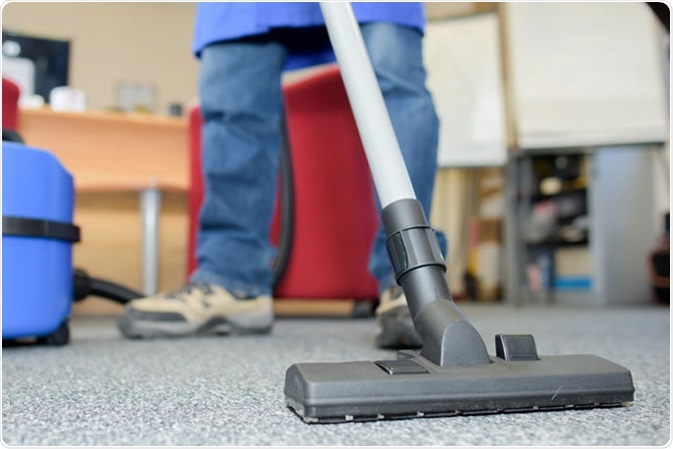Common Allergens in the Workplace and How to Avoid Them
Skip to:
- Allergies at work
- Common allergens related to food
- Other common allergens
- How your employer can create a safe working environment
Up to 2% of the adult population in the UK have reported having allergies or intolerances. Some people may experience mild allergies, such as hay fever, whilst others can have severe reactions and go into anaphylactic shock.
People suffering from allergies know how to avoid triggers when they are in a controlled environment like their home. However, when it comes to the workplace there is less you can do because you don’t have control over the ventilation system, location of the workplace, humidity, temperature levels and the materials used during work. It is therefore vital that employers ensure the safety of the working environment be it an office, healthcare institution, education institution or an outdoor facility.

Allergies at Work
A study of office workers conducted by Allergy UK in 2012 showed that 95% of allergy sufferers surveyed have experienced allergy symptoms while at work such as breathing problems, eye conditions, headaches, skin irritations and nasal problems.
According to the survey, there are numerous triggers at the workplace, the most common are dust, pollen and mould. These invisible allergens are very common in the office, especially in carpeted surfaces and cluttered desks.
As soon as you start a job at a new place you need to speak to your employer about any allergies that you have. The most common allergens in the workplace tend to be associated with food. In some workplaces employees store their food in a common kitchen and this can be a potential risk factor for those who suffer from food allergies due to the easy distribution of allergens. That is why you, as an employee, need to discuss any accommodations that need to be made with your employer. After this there are a number of things you can do to create a safe environment for yourself:
- Talk with the people you work with. After discussing your allergy with your employer it is also advisable to speak to your colleagues. This is a good way to ensure that they understand your situation and will not do anything to accidently trigger your allergies.
- Take precautions. No matter how careful you are, accidental exposure to allergens can still happen at your workplace. In these situations you need to be prepared and always carry allergy meditation with you.
- Make sure your desk is clean so that does not becoming a source of dust and any other allergens that can make you symptoms worse.
- In case there are plants in the workplace, they should be regularly watered and the top layer of soil removed to prevent the development of mould.
- Coats and jackets should be kept separate from the working area as they can carry dust, pollen and pet hair, all of which can be risky allergens.
Common allergens related to food
Even though any type of food can cause an allergic reaction, there are some common foods that are the main cause for allergies. The most common food allergens are sesame, peanuts, shellfish, milk and eggs. Informing your colleagues about your specific allergies and storing your food separately can help you avoid dangerous contact with allergens. This way you can prevent cross-contamination which happens when an allergen is accidentally transferred from one object to another, which is often the case in common kitchen areas at the workplace.
Other common allergens
Depending on the time of the year different pollen allergies can present higher risks. Keeping the workplace well ventilated and avoiding opening windows during peak pollen times can be very helpful when avoiding allergy symptoms. Pet hair is another common allergen which can easily be tranfered in the workplace.
How your employer can create a safe working environment
Creating a safe working environment is part of the employer’s Duty of Care under the Health and Safety at Work Act 1974. In order to create allergens free environment there are some steps that can be undertaken.
- First of all, employers need to be aware of their employees’ allergies. So you need to make sure you notify your employer prior to beginning to work for them.
- The workplace should be properly ventilated. However, in cases of pollen allergies, windows should be kept closed to avoid pollen distribution.
- Raise awareness with your employees by conducting training sessions with the aim to increase the knowledge and understanding of allergies and what causes them.
- Make sure some employees are first aid trained and understand the symptoms of an allergic reaction.
- Create an environment that is safe by making sure that employees that have food allergies have a place to store their food separately from the rest of the people in the workplace. Also, if any food is provided by the buisness take into consideration any allergens that can be a potential threat.
If you suffer from allergies, be it at home or at the workplace you should always take measures to create an allergen-free environment. It is important to notify your employer of your allergies so they can take safe measures to secure the workplace if there are any potential allergy triggers.
References
- Supporting People at Risk of Severe Allergies. https://www.anaphylaxis.org.uk/wp-content/uploads/2018/11/Managing-Allergens-in-the-Workplace-A-guide-for-Employers-and-Employees.pdf
- Korpi, A. (2007). Controlling Occupational Allergies at Work. https://www.degruyter.com/downloadpdf/j/ijmh.2007.20.issue-2/v10001-007-0018-0/v10001-007-0018-0.pdf
Further Reading
- All Allergy Content
- What are Allergies?
- Different Types of Allergies
- Old Friends Hypothesis
- What is the Microbial Diversity Hypothesis?
Last Updated: Oct 17, 2019

Written by
Mihaela Dimitrova
Mihaela's curiosity has pushed her to explore the human mind and the intricate inner workings in the brain. She has a B.Sc. in Psychology from the University of Birmingham and an M.Sc. in Human-Computer Interaction from University College London.
Source: Read Full Article
